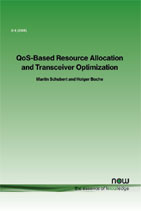QoS-Based Resource Allocation and Transceiver Optimization
By Martin Schubert, Fraunhofer German-Sino Lab for Mobile Communications MCI, Germany, schubert@hhi.fhg.de | Holger Boche, Technical University of Berlin, Dept. of Electrical Engineering, Heinrich-Hertz Chair for Mobile Communications, Germany and Fraunhofer German-Sino Lab for Mobile Communications MCI, Germany and Fraunhofer Institute for Telecommunications, Heinrich-Hertz-Institut (HHI), Germany, boche@hhi.fhg.de
Abstract
The control and reduction of multiuser interference is a fundamental problem in wireless communications. In order to increase the spectral efficiency and to provide individual quality-of-service (QoS), it is required to jointly optimize the power allocation together with possible receive and transmit strategies. This often leads to complex and difficult-to-handle problem formulations. There are many examples in the literature, where the special structure of the problem is exploited in order to solve special cases of this problem (e.g. multiuser beamforming or CDMA). So it is desirable to have a general theory, which can be applied to many practical QoS measures, like rates, delay, BER, etc. These measures can all be related to the signal-to-interference ratio (SIR) or the signal-to-interference-plus-noise ratio (SINR). This leads to the problem of SIR and SINR balancing, which is fundamental for many problems in communication theory.
In this text we derive a comprehensive theoretical framework for SIR balancing, with and without noise. The theory considers the possible use of receive strategies (e.g. interference filtering or channel assignment), which can be included in the model in an abstract way. Power allocation and receiver design are mutually interdependent, thus joint optimization strategies are derived. The main purpose of this text is to provide a better understanding of interference balancing and the characterization of the QoS feasible region. We also provide a generic algorithmic framework, which may serve as a basis for the development of new resource allocation algorithms.
We study different interference models, which are general enough to be valid for a wide range of system designs, but which are also specific enough to facilitate efficient algorithmic solutions. One important class of interference functions is based on axioms, which characterize the impact of the power allocation of the interference received by the individual users. Another class of interference functions is based on non-negative coupling matrices, which may be parameter-dependent in order to model the possible impact of receive strategies. Both models are studied with and without noise. We analyze the resulting QoS feasible region (the set of jointly achievable QoS) and discuss different allocation strategies for min-max fairness and sum-power minimization. Finally we study geometrical properties of the QoS region, which can be shown to be convex for log-convex interference functions.
QoS-Based Resource Allocation and Transceiver Optimization
QoS-Based Resource Allocation and Transceiver Optimization derives a comprehensive theoretical framework for SIR balancing, with and without noise. The theory considers the possible use of receive strategies (e.g. interference filtering or channel assignment), which can be included in the model in an abstract way. Power allocation and receiver design are mutually interdependent, thus joint optimization strategies are derived.
QoS-Based Resource Allocation and Transceiver Optimization provides a better understanding of interference balancing and the characterization of the QoS feasible region. It also provides a generic algorithmic framework, which may serve as a basis for the development of new resource allocation algorithms.
QoS-Based Resource Allocation and Transceiver Optimization is an invaluable resource for every communications engineer and researcher working on multiuser interference problems in wireless communications.
